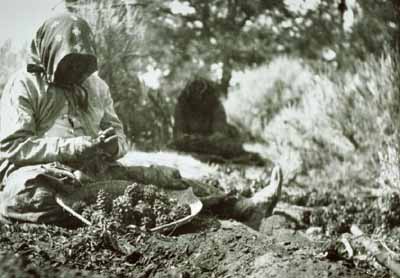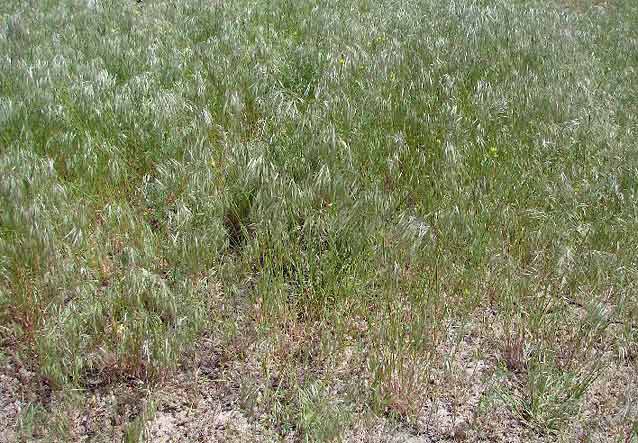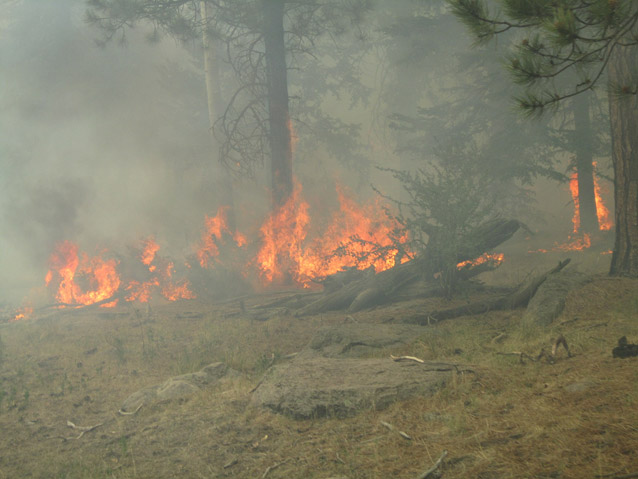Human beings have a long history of utilizing pinyon-juniper woodlands and the many resources they contain for everything from food and medicine to building materials. After the arrival of Euro-American settlers in the late 1800s, exploitation increased, and many other ecosystem stressors such as fragmentation and invasive plants were introduced.
Anthropogenic Use and Post-settlement Stressors

Library of Congress (http://www.loc.gov/item/ncr001396/).
Native American Use of Pinyon-Juniper Woodlands
Wood and bark artifacts, such as digging sticks, cradleboards, arrow shafts, weaving tools, and bundles of juniper bark, provide evidence that, as long as 10,000 years ago, Paleo-Indian peoples were using the plants of pinyon-juniper woodlands for clothing, tools, house-building material, food, and medicine, and as fuel for heating, cooking, and firing pottery (Flint-Lacey 2003; Cartledge and Propper 1993). These ancient peoples relied heavily on pinyon pine nuts, which had significant nutritional value and contained proteins, carbohydrates, fats, and two amino acids that are present only at low levels in other regional indigenous plant foods (Litzinger 2003). Pinyon, juniper, and associated species of vegetation continue to be harvested and utilized by modern peoples today.
By A.D. 1300, after over 1,000 years of occupation, the ancient Puebloan peoples had abandoned the region of Mesa Verde, Colorado (Flint-Lacey 2003). Some evidence indicates that they may have depleted the pinyon-juniper resources near their settlements, and that deforestation may have been one of the factors that contributed to the abandonment of settlements in this area (Flint-Lacey 2003, Litzinger 2003). A dramatic decline in pinyon remains found at late Ancestral Pueblo archaeological sites suggests an intensive, widespread forest clear-cutting near the end of this period of occupation (Litzinger 2003). Archaeological surveys at Bandelier National Monument, southeast of Mesa Verde, revealed significant impacts to pinyon-juniper woodland resources during a period of peak occupation, from A.D. 1200 to 1500 (Gottfried et al. 1995). Flint-Lacey (2003) and Litzinger (2003) suggest that only small, remnant pinyon-juniper stands remained in the Mesa Verde region by A.D. 1300.
Post-settlement Stressors
A host of anthropogenic disturbance factors have affected pinyon-juniper woodlands since Euro-American settlement in the late 1800s. Post-settlement anthropogenic stressors included timber harvest, livestock grazing, landscape fragmentation, the introduction of invasive exotic organisms, and altered fire regimes. Post-settlement changes observed in pinyon-juniper woodlands included a loss of herbaceous groundcover in some regions, a shift from pinyon to juniper dominance in others, increased tree density, and soil erosion. It is difficult to attribute these changes to any one stressor or disturbance factor. Rather, we should consider that pinyon-juniper woodlands are continually influenced by the complex interplay of multiple natural disturbances and anthropogenic stressors.
Timber harvest
Pinyon-juniper woodlands have long been an important source of fuel for domestic heating, cooking, and building material, in both pre- and post-settlement times. Pinyon and juniper wood was also a major source for fuel for mining operations in the 1800s, and continues to be widely used for domestic heating and cooking today. Historically, impacts of unsustainable timber harvest were most likely concentrated around population centers.
Livestock grazing
A marked increase in pinyon-juniper tree density and extent over the past century has been attributed by many researchers to a combination of livestock grazing and the disruption of historical wildfire regimes (Gori and Bate 2007; Gottfried et al. 1995). Some have hypothesized that livestock grazing has aided the spread of juniper into grasslands by reducing the density of grasses and palatable shrubs that compete with juniper seedlings for soil moisture, nutrients, and other limiting factors (Johnsen 1962). Livestock overgrazing has modified fire regimes and erosion processes across multiple spatial scales by altering the density and spatial patterning of groundcover (Allen 2007). More trees survive in the absence of fire, further reducing vegetative groundcover by outcompeting grasses and forbs for limited soil moisture. Livestock can also transport non-native, invasive weed seed from weed-infested rangelands into more pristine areas, where they, too, can outcompete native grasses and forbs.
Erosion
Pinyon-juniper woodland systems in the southwestern United States are particularly susceptible to erosion. When fire, livestock grazing, or drought reduces the amount of vegetative ground cover and organic litter, rates of soil erosion during and after precipitation events can increase dramatically. Where appropriate grazing management systems are not implemented, livestock grazing contributes to soil erosion by compacting the soil. Soil compaction reduces the amount of water that filters down through the soil (infiltration) and increases surface water runoff. As a result, topsoil is lost and large quantities of sediment are deposited by surface runoff into rivers and streams, negatively impacting water quality and aquatic habitat.
Furthermore, livestock, off-road vehicles, hikers, and other types of mechanical disturbance damage biological soil crusts (communities of bacteria, cyanobacteria, lichens, mosses, algae, and/or fungi on the soil surface). These crusts reduce erosion from wind and water, hold nutrients and moisture, enrich the soil via atmospheric nitrogen fixation, and initiate primary succession by re-colonizing disturbed areas (Gottfried et al. 1995). Biological soil crusts play an important role in reducing surface runoff and erosion, but they are fragile and can be slow to recover after disturbance (Belnap and Eldridge 2001).
Fragmentation
Many woodland ecosystem properties are a function of forest patch size and pattern (Allen and Breshears 1998). Patches of tree mortality within a stand can be caused by insect outbreaks, mixed-severity fire, drought, and climate-driven shifts in the transition zones between vegetation community types (ecotones). Levels of surface water runoff and erosion are affected when vegetation structure is disturbed. Wilcox et al. (2003) measured levels of runoff and erosion in semi-arid pinyon-juniper woodlands in northern New Mexico. Following precipitation events, levels of runoff and erosion were found to be higher in individual patches of vegetation than in large areas of uninterrupted vegetation. Furthermore, the cumulative impacts of erosion were more likely to persist on steep-slope sites, whereas low-slope gradient sites were more resilient and better able to return to pre-disturbance levels of runoff and erosion over time.
Exotic invasive plants
Natural and anthropogenic disturbances, such as drought, fire, timber harvest, livestock grazing, road construction, and erosion create conditions that allow non-native invasive species to become established. Invasive species can be introduced into pinyon-juniper woodlands through many pathways (vectors). Weed seeds, or material harboring exotic insects, or plant pathogens may travel on recreationists’ gear or road building equipment. Weed seeds may be present as a contaminant in broadcast seed mixes used for revegetation or erosion control. Seeds of exotic plants are also transported in the digestive tracts of livestock, and moved from infested to uninfested areas. Once established, many non-native invasive plants can out-compete native vegetation for space, moisture, nutrients, and other limiting factors. They spread aggressively and are difficult to control, as they have few natural enemies in their new environment. Some exotic plants that cause concern in pinyon-juniper woodlands include cheatgrass (Bromus tectorum), knapweeds (Centaurea spp.), thistles (Cirsium spp., Carduus spp., and Onopordum spp.), mustards (Sisymbrium spp. and Brassica spp.), and Dalmatian toadflax (Linaria dalmatica).

Photo by Cassondra Skinner, hosted by the USDA-NRCS PLANTS Database.
Altered fire regimes
Natural (historical) fire regimes for each of the three types of pinyon-juniper woodlands are briefly described in Table 1. Limited information is available on pre-European settlement fire disturbance history and successional dynamics in these forests. Land managers seeking to understand how natural disturbance events have been influenced by anthropogenic factors in post-settlement times are challenged by a lack of research focused on pinyon-juniper systems and a lack of evidence of past fires on the landscapes. Neither pinyon nor juniper reliably forms fire scars like ponderosa pine and other conifer species. Both pinyon pines and junipers, with thin bark and low crowns, are easily killed by wildfire. With the exception of young alligator juniper, pinyon and juniper species do not re-sprout after fire as do associated species of shrubs and oaks, but take several decades to become re-established by seed. Although dead juniper snags can be persistent on the landscape, they are difficult for researchers to age.
The introduction and expansion of livestock grazing throughout much of the Southwest removed the fine herbaceous fuels that create a continuous layer of combustible material over the surface of the landscape. Combined with fire detection and suppression efforts in the 20th century, fire frequency has been reduced, but fires have tended to burn with greater intensity when they do occur. The frequency of large, severe fires has increased over the past 20 years in pinyon-juniper woodlands and other vegetation communities, across the western United States (Romme et al. 2008).

Photo by Glen Simpson, NPS.
Implications for pinyon-juniper savanna
Historically, frequent, low-intensity surface fires helped to maintain grasses and the characteristic open stand structure of this type of woodland. Extensive infill of trees into juniper savanna and shrublands has been documented throughout the 20th century, but it is difficult to tell whether this is new expansion of woodland into savanna and shrublands, natural range expansion, or recovery of persistent woodlands after disturbance in the distant past (Romme et al. 2008). An example of this type of pinyon-juniper infill into savanna is occurring at Bandelier National Monument (Floyd et al. 2000). Stand thinning and prescribed burning are two of the management tools applied by land managers in these systems to mimic historical disturbance regimes.
Implications for wooded shrubland
Over the past century, increased tree density and cover have been observed in wooded shrublands, due in part to livestock grazing and active fire suppression (Johnsen 1962). The increased fuel loads and canopy closure in these areas may result in larger, more severe fires than those of the 1800s (Gori and Bate 2007). While this trend of increased tree density has been observed in Great Basin shrublands and portions of Arizona and New Mexico, it is balanced by very limited increases in tree density in portions of western Colorado (Romme et al. 2008), and by the drought-induced tree mortality which has been observed in Colorado and New Mexico, and other regions.
Implications for persistent woodland
Tree density and cover have gradually increased over the past century in many pinyon-juniper woodlands, possibly due to favorable climatic conditions during portions of the past century. It is likely that wildfire has had less of an impact on persistent woodland stand dynamics than other natural disturbance factors, such as drought, insects, and disease (Romme et al. 2008). Romme et al. (2008) state that surface fires have had a very limited influence on pinyon-juniper persistent woodland stands in the historical landscape. Aside from small, isolated fires ignited by lightning, persistent woodlands can remain undisturbed by fire for hundreds of years at a time (Romme et al. 2008). As a result of research in Mesa Verde National Park, Floyd et al. (2000) suggest that pinyon-juniper persistent woodlands were never subject to a regime of frequent low-intensity fires, but were shaped by a historical fire regime of rare but stand-replacing fires. In this sense, prescribed fire may not mimic natural disturbance regimes in persistent woodland systems.
Part of a series of articles titled Pinyon-Juniper Woodlands.
Last updated: February 4, 2015
